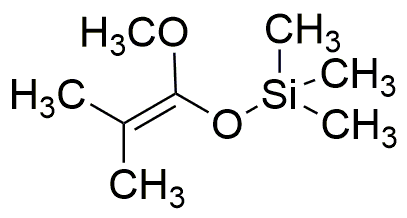Dimethylketene methyl trimethylsilyl acetal is widely utilized in research focused on:
- Synthetic Chemistry: This compound serves as a versatile building block in organic synthesis, enabling the formation of complex molecules efficiently.
- Pharmaceutical Development: It plays a crucial role in the synthesis of pharmaceutical intermediates, facilitating the creation of new drugs with improved efficacy.
- Polymer Science: The compound is used in the production of specialty polymers, enhancing properties such as flexibility and thermal stability.
- Agricultural Chemistry: It is applied in the formulation of agrochemicals, contributing to the development of effective pesticides and herbicides.
- Analytical Chemistry: This chemical is utilized in various analytical techniques, aiding in the detection and quantification of other compounds in complex mixtures.
General Information
Properties
Safety and Regulations
Applications
Dimethylketene methyl trimethylsilyl acetal is widely utilized in research focused on:
- Synthetic Chemistry: This compound serves as a versatile building block in organic synthesis, enabling the formation of complex molecules efficiently.
- Pharmaceutical Development: It plays a crucial role in the synthesis of pharmaceutical intermediates, facilitating the creation of new drugs with improved efficacy.
- Polymer Science: The compound is used in the production of specialty polymers, enhancing properties such as flexibility and thermal stability.
- Agricultural Chemistry: It is applied in the formulation of agrochemicals, contributing to the development of effective pesticides and herbicides.
- Analytical Chemistry: This chemical is utilized in various analytical techniques, aiding in the detection and quantification of other compounds in complex mixtures.
Documents
Safety Data Sheets (SDS)
The SDS provides comprehensive safety information on handling, storage, and disposal of the product.
Product Specification (PS)
The PS provides a comprehensive breakdown of the product’s properties, including chemical composition, physical state, purity, and storage requirements. It also details acceptable quality ranges and the product's intended applications.
Certificates of Analysis (COA)
Search for Certificates of Analysis (COA) by entering the products Lot Number. Lot and Batch Numbers can be found on a product’s label following the words ‘Lot’ or ‘Batch’.
Numéro de catalogue
Numéro de lot/série
Certificates Of Origin (COO)
This COO confirms the country where the product was manufactured, and also details the materials and components used in it and whether it is derived from natural, synthetic, or other specific sources. This certificate may be required for customs, trade, and regulatory compliance.
Numéro de catalogue
Numéro de lot/série
Safety Data Sheets (SDS)
The SDS provides comprehensive safety information on handling, storage, and disposal of the product.
DownloadProduct Specification (PS)
The PS provides a comprehensive breakdown of the product’s properties, including chemical composition, physical state, purity, and storage requirements. It also details acceptable quality ranges and the product's intended applications.
DownloadCertificates of Analysis (COA)
Search for Certificates of Analysis (COA) by entering the products Lot Number. Lot and Batch Numbers can be found on a product’s label following the words ‘Lot’ or ‘Batch’.
Numéro de catalogue
Numéro de lot/série
Certificates Of Origin (COO)
This COO confirms the country where the product was manufactured, and also details the materials and components used in it and whether it is derived from natural, synthetic, or other specific sources. This certificate may be required for customs, trade, and regulatory compliance.


